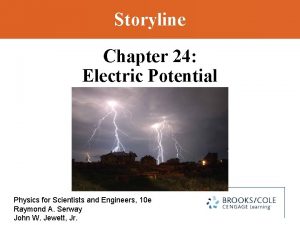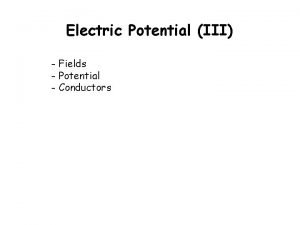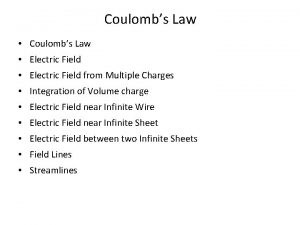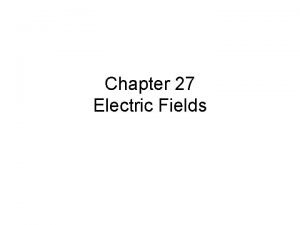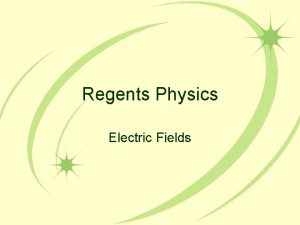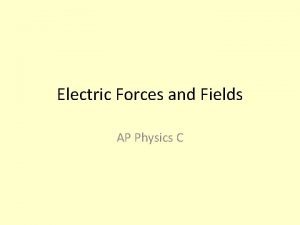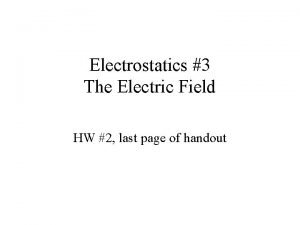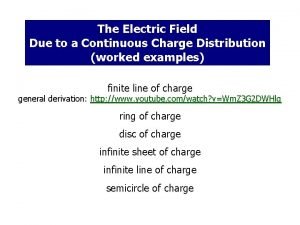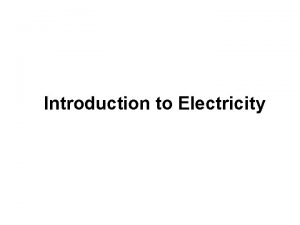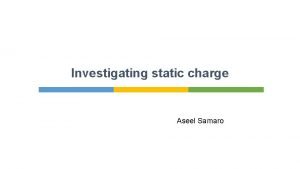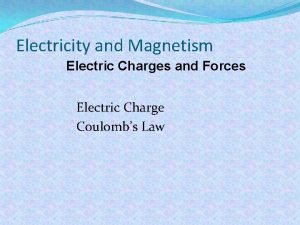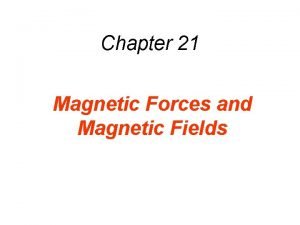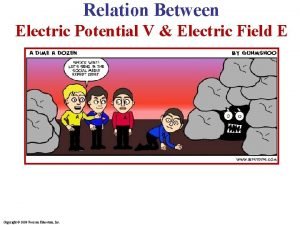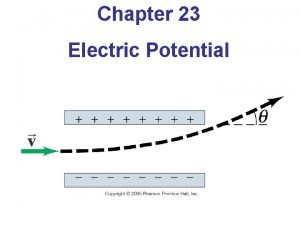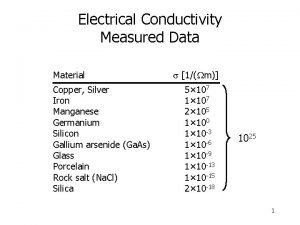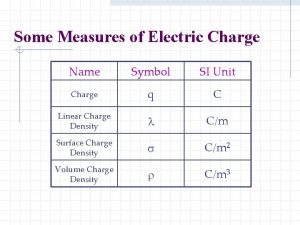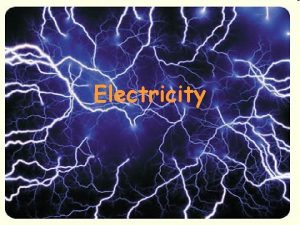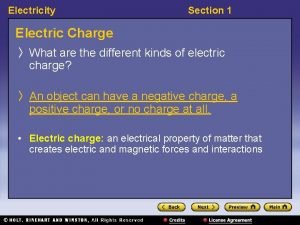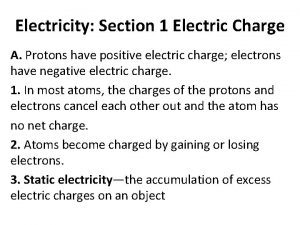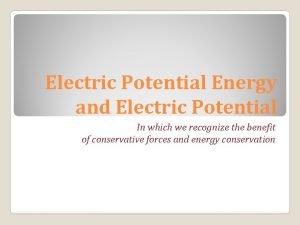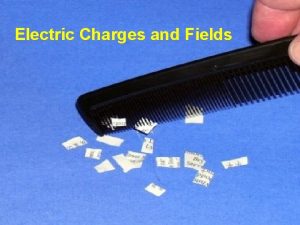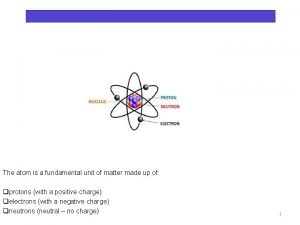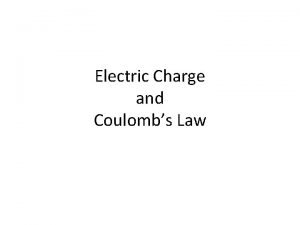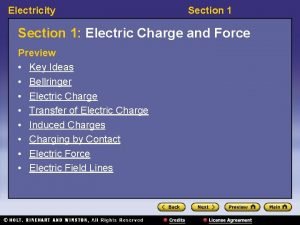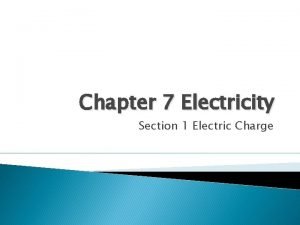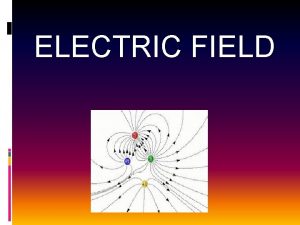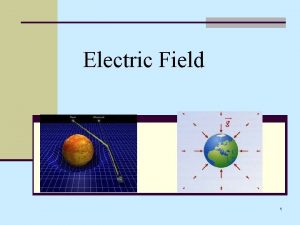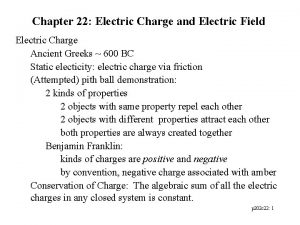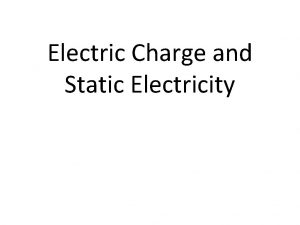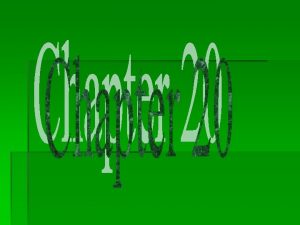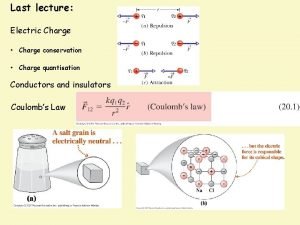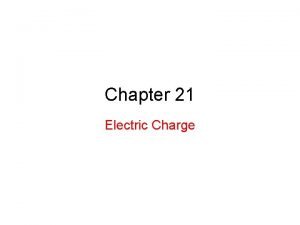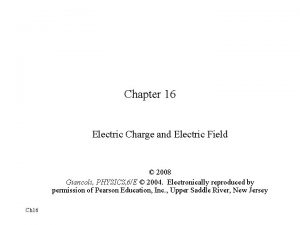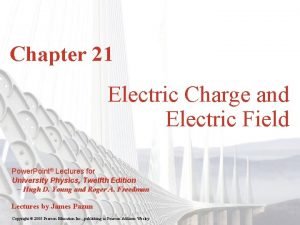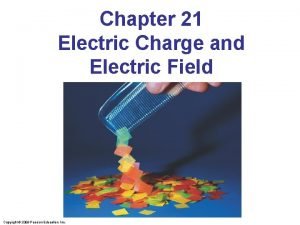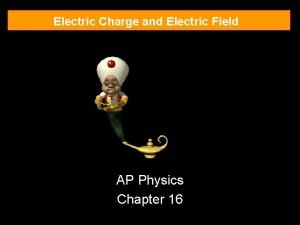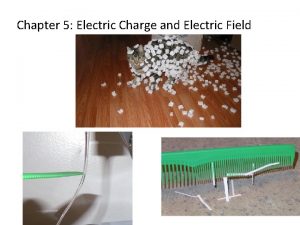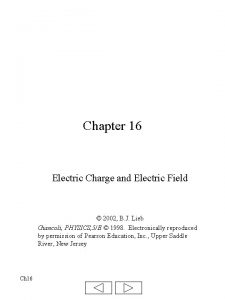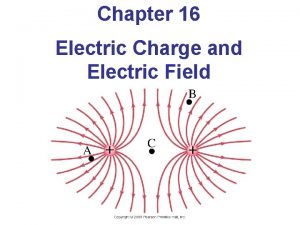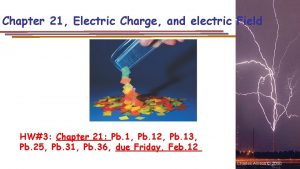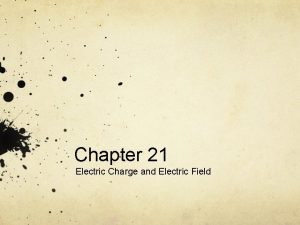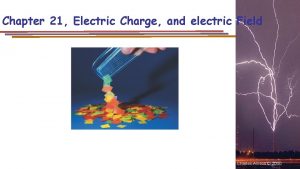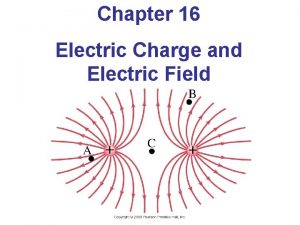Chapter 17 Electric Charge and Electric Field Two














































- Slides: 46

Chapter 17 Electric Charge and Electric Field

Two kinds of charges: positive and negative • Two charges of the same kind REPEL each other • Two charges of different kinds ATTRACT each other

Coulomb’s Law • The magnitude F of the force that each of two point charges q 1 and q 2 exerts on each other when they are separated by a distance r is directly proportional to the product of the two charges and inversely proportional to the distance squared F = k |q 1 q 2|/r 2

Additive forces r 12 q 1 r 23 q 2 r 13 q 3

ELECTRIC FIELD





GAUSS’s LAW The total flux ΦE coming out of any closed surface is proportional to the total electric charge Qencl inside the volume surrounded by this surface. ΦE = Qencl / ɛo Ɛo = 8. 854 x 10 -12 C 2/(N. m 2)

Chapter 18 Electric Potential and Capacitance

ELECTRIC POTENTIAL ENERGY Electric potential energy is between two charges (q and q’ ) separated by a distance r and is defined as: PE = kqq’/r Electric potential energy is a scalar and has units of Joule (J). When there are more than 2 charges, the total potential energy is the sum of the energy associated with each pair of charges

• In the gravitational case, the change in the potential energy associated with an object with mass m when moved from the surface to a height h is mgh Similarly, the electric potential energy associated with a charge q in a field E is: q. Ed When the charge is moved a distance d along or opposite direction of the field

ELECTRIC POTENTIAL or VOLTAGE • A charge Q creates an electric field around it. Similarly, this charge will create an electric potential V around it, commonly called voltage It is a scalar and is defined as: V = k. Q/r The unit for electric potential is the Volt (V). Consequently, when a charge q is placed at a distance r from Q, the electric potential energy between the two charges would be: U = q. V

ELECTRIC POTENTIAL and ELECTRIC FIELD • For parallel plates separated by a distance d and a potential difference between them V the field between the plates is then: E= V/d Or V=Ed

DEFINITION • The CAPACITANCE C of a capacitor is the ratio of the magnitude of the charge Q on either conductor (plate) to the magnitude of the potential Vab between the conductors (plates): C =Q/Vab The SI unit of capacitance is FARAD (1 farad = 1 C/1 V)

CAPACITANCE FOR PARALLEL PLATES • If the capacitor is made of parallel plates with surface area A and a separation d between the plates, the capacitance is: C = ɛ 0 A/d

Capacitors are often joined


Capacitors are often joined II – Figures 18. 22


Electric Field Energy in a Capacitor • One of the applications of the capacitor is to store energy (analogous to the potential energy stored in a spring) Ucapacitor = (1/2) CV 2

Chapter 19 Current, Resistance, and Directed -Current Circuits

Current defined Unit: 1 coulomb/second = 1 ampere = 1 A

Resistance and Ohm’s Law • When the potential difference V between the two ends of a conductor is proportional to the current I passing through the conductor, the ratio (V)/(I) is called the resistance of the conductor : R = V/I The SI unit for resistance is the ohm and it is represented by the Greek letter Ω 1Ω = 1 V/A

Resistivity • The resistance is the property of a given conductor and it depends on its length L and cross- section area A R = ρ L/A L ρ characterizes the conduction properties of the material

Power in Electric Circuit The power P is defined as P = Vab. I The unit for power is the watt 1 W = 1 J/s

Power for a pure resistor: For a pure (single) resistor, we have: P=Vab. I Since V= RI P = RI 2 or P = V 2 ab/R

Connections in series Req = R 1 + R 2 + R 3 SAME CURRENT DIFFERENT POTENTIAL

Connections in parallel 1/Req = 1/R 1 + 1/R 2 + 1/R 3 SAME POTENTIAL DIFFERENT CURRENT

Just after two identical point charges are released when they are a distance D apart in outer space, they have an acceleration a. If you release them from a distance D/2 instead, their acceleration will be A. a/4 B. 4 a C. 2 a D. a/2

Just after two identical point charges are released when they are a distance D apart in outer space, they have an acceleration a. If you release them from a distance D/2 nstead, their acceleration will be A. a/4 B. 4 a C. 2 a D. a/2 F = k |q 1 q 2|/D 2 a = F/m 4 a

If the electric field is E at a distance d from a point charge, its magnitude will be 2 E at a distance: A. d/4 B. d/2 C. d/ D. d E. 2 d

If the electric field is E at a distance d from a point charge, its magnitude will be 2 E at a distance: A. d/4 B. d/2 C. d/ D. d E. 2 d E = k q/d 2 C

Two unequal point charges are separated as shown in the figure The electric field due to this combination of charges can be zero A. only in region 1. B. only in region 2. C. only in region 3. D. in both regions 1 and 3.

Two unequal point charges are separated as shown in the figure The electric field due to this combination of charges can be zero A. only in region 1. B. only in region 2. C. only in region 3. D. in both regions 1 and 3.

Two protons close to each other are released from rest and are completely free to move. After being released (there may be more than one correct choice), A. their speeds gradually decrease to zero as they move apart. B. their speeds gradually increase as they move apart. C. their accelerations gradually decrease to zero as they move apart. D. their accelerations gradually increase as they move apart.

Two protons close to each other are released from rest and are completely free to move. After being released (there may be more than one correct choice), A. their speeds gradually decrease to zero as they move apart. B. their speeds gradually increase as they move apart. C. their accelerations gradually decrease to zero as they move apart. D. their accelerations gradually increase as they move apart.

• A spherical balloon contains a charge +Q uniformly distributed over its surface. When it has a diameter D , the electric field at its surface has magnitude E. If the balloon is now blown up to twice this diameter without changing the charge, the electric field at its surface is A. 4 E B. 2 E C. E/4 D. E/2

• A spherical balloon contains a charge +Q uniformly distributed over its surface. When it has a diameter D , the electric field at its surface has magnitude E. If the balloon is now blown up to twice this diameter without changing the charge, the electric field at its surface is A. 4 E B. 2 E C. E/4 D. E/2

An electron is moving horizontally in a laboratory when a uniform electric field is suddenly turned on. This field points vertically downward (in the plane of the paper). Which of the paths shown will the electron follow, assuming that gravity can be neglected?

An electron is moving horizontally in a laboratory when a uniform electric field is suddenly turned on. This field points vertically downward (in the plane of the paper). Which of the paths shown will the electron follow, assuming that gravity can be neglected?

In the figure below, point P is equidistant from both point charges. • • • At that point (there may be more than one correct choice), A. the electric field points directly to the right. B. the electric field is zero. C. the potential (relative to infinity) is zero. D. the potential (relative to infinity) points upward.

In the figure below, point P is equidistant from both point charges. • At that point (there may be more than one correct choice), • A. the electric field points directly to the right. • B. the electric field is zero. • C. the potential (relative to infinity) is zero. • D. the potential (relative to infinity) points upward. V is a scalar and is defined as: V = k. Q/r

For the capacitor network shown in the figure below a constant potential difference of 50. 0 V is maintained across points a and b by a battery. Which of the following statements about this network is correct? A. The 10 μF and 20 μF capacitors have equal charges. B. The charge on the 20 μF capacitor is twice the charge on the 10 μF capacitor. C. The potential difference across the 10 μF capacitor is the same as the potentia difference across the 20 μF capacitor. D. The equivalent capacitance of the network is 60 μF.

For the capacitor network shown in the figure below a constant potential difference of 50. 0 V is maintained across points a and b by a battery. Which of the following statements about this network is correct? A. The 10 μF and 20 μF capacitors have equal charges. B. The charge on the 20 μF capacitor is twice the charge on the 10 μF capacitor. C. The potential difference across the 10 μF capacitor is the same as the potentia difference across the 20 μF capacitor. D. The equivalent capacitance of the network is 60 μF.
 Chapter 21 electric charge and electric field
Chapter 21 electric charge and electric field Chapter 21 electric charge and electric field
Chapter 21 electric charge and electric field Unit of charge
Unit of charge Dc o/d per item charge
Dc o/d per item charge Difference between charge and electric charge
Difference between charge and electric charge Difference between charge and electric charge
Difference between charge and electric charge Gauss law of magnetism
Gauss law of magnetism Electric field and magnetic field difference
Electric field and magnetic field difference Difference between electric field and magnetic field
Difference between electric field and magnetic field Electric field of a finite line charge
Electric field of a finite line charge Electric field due to infinitely long straight wire
Electric field due to infinitely long straight wire Electric field of a finite line charge
Electric field of a finite line charge Electric field for infinite line charge
Electric field for infinite line charge Electric field at a point formula
Electric field at a point formula Electric field si units
Electric field si units Electric field lines about a point charge extend
Electric field lines about a point charge extend Electric field of line charge
Electric field of line charge Force on charge in electric field
Force on charge in electric field Electric field due to a continuous charge distribution
Electric field due to a continuous charge distribution Electric field equation
Electric field equation Electric potential and electric field
Electric potential and electric field Potential energy due to point charges
Potential energy due to point charges Potential energy of capacitor
Potential energy of capacitor Chapter 17 section 1 electric charge and force answer key
Chapter 17 section 1 electric charge and force answer key Chapter 6 section 1 electric charge worksheet answers
Chapter 6 section 1 electric charge worksheet answers Symbol q in electricity
Symbol q in electricity Database field types and field properties
Database field types and field properties Field dependent definition
Field dependent definition Force on a charge in magnetic field
Force on a charge in magnetic field Does magnetic field exerts force on a static charge
Does magnetic field exerts force on a static charge Electric force equation
Electric force equation Does magnetic field exerts force on a static charge
Does magnetic field exerts force on a static charge A uniformly charged conducting sphere
A uniformly charged conducting sphere Emf and electric field
Emf and electric field Electric potential to work
Electric potential to work Copper conductivity s/m
Copper conductivity s/m Surface charge density symbol
Surface charge density symbol What is electric charge measured in
What is electric charge measured in Section 1 electric charge crossword puzzle answers
Section 1 electric charge crossword puzzle answers Section 1 electric charge crossword puzzle answers
Section 1 electric charge crossword puzzle answers Example of charge by contact
Example of charge by contact What is the potential at point a
What is the potential at point a Amber effect
Amber effect Electric charge
Electric charge Columbs law
Columbs law Section 1 electric charge
Section 1 electric charge Electricity section 1 electric charge
Electricity section 1 electric charge









